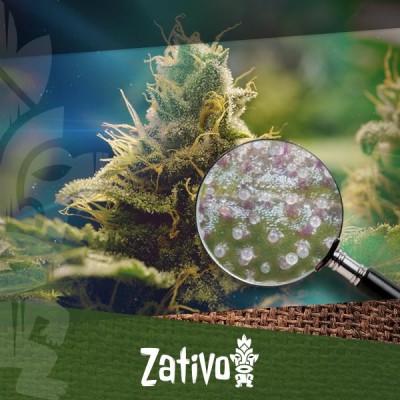Don't have an account?
Register NowYou have to add to cart at least 5 bottles or any program to make checkout.
- BlogThe Best Methods To Increase Trichome Production
The Best Methods To Increase Trichome Production
Published: October 26th, 2018
Categories:
Cannabis Cultivation
THE SECRETS OF SWEET CANNABIS LEAF
There are many guides promoting risky high-stress strategies to increase trichome production. All of them are worthless. If you’re willing to resort to weed witchcraft in expectation of resin-coated reefer, you are doomed. This is beyond “trust me I’m a professional”—we are talking to you as fellow patrons of the last chance saloon. We’ve tried every magical and misguided marijuana potency enhancer, and none of them could be described as a silver bullet for sparkling sinsemilla.
However, there are ways to dramatically increase the potency of your cannabis and really make buds glisten with gooey resin. But you’ve got to be prepared to put in the work. By implementing as many or as few techniques as your cannabis garden requires, you’ll see results come harvest. And you’ll confirm it when you smoke the righteous resinous reefer.
FEED CANNABIS FLOWERS AND BE PATIENT
During vegetative growth, your cannabis plants need higher doses of N (nitrogen). When your plants transition to the flowering phase, it’s critical to focus on feeding flowers. If you continue to feed blooming plants nitrogen-rich fertiliser, they will grow more leaves and stems than flowers.
Flowering cannabis requires more P (phosphorus) and K (potassium) than N. The grower must switch to bloom base nutrients and supplements as a result. This can be a problematic adjustment to the feeding schedule and may alter the pH of the water differently than the vegetative growth nutrient solution.
Too much N late in flowering will delay harvest. A thorough flush with pure water or a light flushing solution for the final 1–2 weeks of flowering makes all the difference. Waiting until pistils are 50% red/orange is a good time to commence flushing. Rather than concentrating on loading up on bloom boosters, it’s better to be patient.
Let flowers mature, wait for peak trichome production, and finish with a flush. Get a close up with a scope on those flowers at the end of week 8 for autoflowers and indicas. Inspect the heads of the trichomes for cloudy and amber ones. Perhaps it’s worth continuing flushing for week 9 if your weed is not ripe yet. Rushing plants to harvest can leave you with a substandard stash of immature buds that never hit peak trichome production. All good ganja comes to those who wait.
MARIJUANA PLANT PRUNING AND DEFOLIATION
Shading fan leaves can be a problem for indoor and outdoor growers. Some cannabis plants grow very bushy with large fan leaves that can block light from penetrating bud sites. Pruning away some fan leaves periodically throughout the flowering stage will not stress the plants significantly. Strategic defoliation, such as taking a few sets of leaves at a time, is the safe way to increase light penetration, and therefore trichome production.
Some growers will strip away lower growth by lollipopping plants in early flowering, concentrating plant energy on developing large colas. Flowers directly under grow lamps and in strong sunlight will always shimmer with trichomes. Popcorn buds are not just smaller, they are also less resinous than big, grade A buds. Buds that don’t receive sufficient illumination tend to be leafier and time-consuming to manicure.
MAKE SURE THE DARK PERIOD IS COMPLETELY DARK

Light pollution is the enemy of photoperiod cannabis plants at night. An interruption in the 12 hour dark cycle during bloom is bad news for buds. Autoflowering plants are more tolerant to disturbances, but not indestructible either. So, if you want your cannabis plant to reach her peak trichome production, it pays to make sure nighttime is pitch black. Stressed female cannabis plants can develop intersex traits and produce pollen. Seeded weed is bunk quality. It only takes one intersex plant to pollinate all the female plants growing around her. By maintaining the dark cycle, you can prevent this occurrence from ever happening.
24–48 HOURS OF COMPLETE DARKNESS: DOES IT WORK?

Keeping plants in complete darkness for periods of 24–48 hours or longer prior to harvest is a marijuana myth. This may have originated by confusing the method of keeping plants in darkness for 24 hours prior to switching to 12/12 flowering. It seems likely someone conflated the practice of inducing plants to bloom sooner with the suggested fade-to-black finish.
In fact, it’s probably a bad idea since keeping cannabis plants swollen with fat frosty buds in an extended period of darkness makes them vulnerable. RH will increase in the dark. Worst of all, you won’t be able to get a good look at your cannabis plants for 1–2 days before you harvest. That’s an edge-of-the-seat finale that most cannabis growers can live without. Maybe it does increase trichome production, just not to a degree where we ever noticed the difference. Busted!
GET A HEAD START WITH GREAT GENETICS
Last but not least, you need great cannabis seeds to grow great weed. If you want uber-potent cannabis, you better choose a strain that’s packing THC content fit for a fire-breather. Moreover, this should be a cannabis strain that is suited to your growing environment, or local climate if growing outdoors.
Fortunately, cannabis strains like Lemon Shining Silver Haze , Afgooey, and White Widow have earned a reputation for producing buds oozing with trichomes. Whatever dankness you decide to cultivate, the real secret is this; well-cared-for cannabis plants grown with love and attention will always produce the most trichomes.












